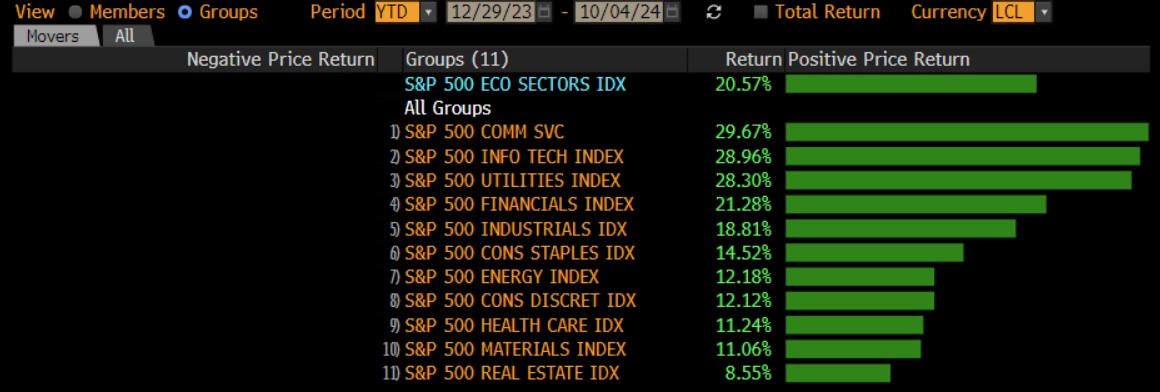- English (UK)
According to FactSet data, earnings growth is expected at 4.2% YoY in the third quarter for the S&P 500 at large, a figure which would represent the fifth straight quarter of earnings growth for the index. Meanwhile, on a revenue basis, the S&P 500 is seen reporting growth of 4.7% YoY, the 16th consecutive quarter of revenue growth, if consensus expectations are realised.
Unsurprisingly, the market at large continues to look relatively expensive per traditional valuation metrics, with the forward 12-month P/E ratio standing at 21.4, broadly unchanged from this time a quarter ago, but considerably above the 5- and 10-year averages of 19.5 and 18.0 respectively.
_spx_v_2024-10-06_11-08-55.jpg)
As is typically the case, earnings expectations have been steadily but surely massaged lower throughout the last quarter. Consensus EPS expectations fell by 3.9% in the third quarter, a considerably larger decline than the 3.3% 5-year average, therefore giving companies substantial room to beat expectations when earnings are released.
This, in many ways, reinforces the importance of forward-looking guidance, particularly when considering the immediate market reaction to earnings releases. Participants will concern themselves not only with whether the company in questions has managed to beat what is a relatively low bar in terms of the report, but also whether or not the accompanying guidance points to a continuation of recent momentum over the quarter ahead.
On a sector basis, only three of the S&P’s 11 sectors are set to report a decline in YoY earnings, with energy set to report the chunkiest such fall. Of the 8 sectors seen reporting YoY earnings growth, Health Care, Information Technology and Communication Services are expected to report double-digit growth, with the latter two coincidentally being the best performing sectors in the index on a YTD basis.

As always, earnings season will get underway with the banks reporting before the opening bell on Friday 11th October. JPMorgan (JPM) and Wells Fargo (WFC) begin proceedings, followed by a bank earnings bonanza on Tuesday 15th, where Bank of America (BAC), Goldman (GS), and Citi (C) all report, with Morgan Stanley (MS) then rounding things out on Wednesday 16th.
Naturally, with the FOMC having now embarked on the process of policy normalisation, by delivering a ‘jumbo’ 50bp cut at the September meeting, investors will pay close attention for signs of how further rate cuts are likely to impact bank profitability.
Elsewhere, while their outperformance over the benchmark S&P 500 has not been anywhere near as vast this year, the high index weights possessed by the ‘Magnificent Seven’ stocks mean that their earnings releases remain key risk events for investors to navigate. Though their report is not due until 21st November, earnings from Nvidia will be closely watched, with the firm trading a whopping 150% higher YTD, and standing as the 2nd best performer in the S&P. More broadly, risks around the AI theme in general appear to have become somewhat more two-sided of late, as investors focus on return timescales for the significant capital expenditure which companies are currently making into this evolving theme.
_mag_7_2024-10-06_11-09-32.jpg)
Of course, earnings season is one of a handful of key risks that participants must navigate between now and the end of the year – namely, the presidential election on 5th November, and two further FOMC decisions, where 25bp cuts are likely at each.
Nevertheless, Q3 reporting season stands as the next of those risks on the horizon, and is particularly important given that solid earnings growth has been one of the key supporting factors - along with strong economic growth, and the forceful ‘Fed put’ – of my long-running equity bull case. I expect earnings growth to meet, or surpass, expectations, hence leaving the path of least resistance pointing to the upside, and with any equity dips likely to still be viewed as buying opportunities.
The material provided here has not been prepared in accordance with legal requirements designed to promote the independence of investment research and as such is considered to be a marketing communication. Whilst it is not subject to any prohibition on dealing ahead of the dissemination of investment research we will not seek to take any advantage before providing it to our clients.
Pepperstone doesn’t represent that the material provided here is accurate, current or complete, and therefore shouldn’t be relied upon as such. The information, whether from a third party or not, isn’t to be considered as a recommendation; or an offer to buy or sell; or the solicitation of an offer to buy or sell any security, financial product or instrument; or to participate in any particular trading strategy. It does not take into account readers’ financial situation or investment objectives. We advise any readers of this content to seek their own advice. Without the approval of Pepperstone, reproduction or redistribution of this information isn’t permitted.
